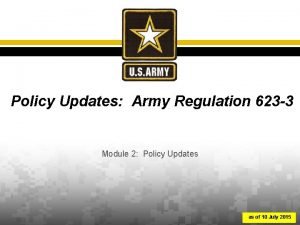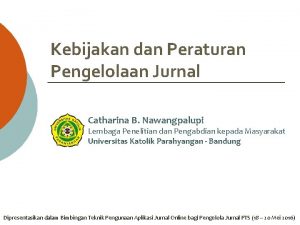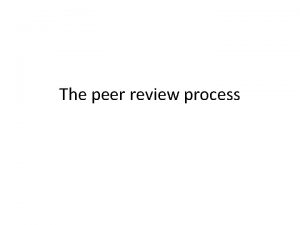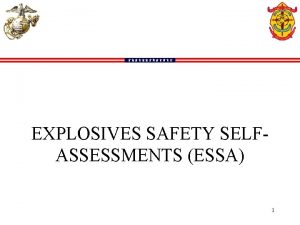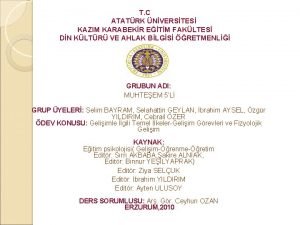ROLE OF THE REVIEWER ESSA KAZIM ROLE OF

















- Slides: 17

ROLE OF THE REVIEWER ESSA KAZIM

ROLE OF THE REVIEWER Refereeing or peer-review has the advantages of: – Identification of suitable scientific material for publication. – Correction of scientific and/or grammatical deficiencies before publication – Prevent the publication of papers of poor scientific quality or those with errors – Assist in the education of authors and improve writing skills The reviewer thus acts as the custodian of the scientific standard of a journal

ROLE OF THE REVIEWER Reviews involve: • Editorial review • Peer review

ROLE OF THE REVIEWER Editorial review • Editorial office ensures that the MS has been submitted in line with ‘Information for Authors’ (format review) • All authors have approved publication • Copyright transfers are included • Figures and tables are in publishable formats • Sources of funding are mentioned If the submission is obviously of poor quality, the editor may convey this to the author without peer review

ROLE OF THE REVIEWER Peer Review • Elevates the professional status of a journal • Reviewers are chosen for their area of expertise which may be very ‘narrow’ e. g. MS may be reviewed by a haematologist with an interest in thrombosis and not just a general haematologist.

ROLE OF THE REVIEWER Peer Review • At least two and preferably three reviewers are used for each MS • Reviewers are generally anonymous to authors; double anonymity is used by some journals. • To avoid conflict of interest, reviewers should not be from the same clinical/research units as authors • Reviewers’ comments are documented and are confidential

ROLE OF THE REVIEWER REVIEW ELEMENTS • • Appropriateness Originality Ethics Study design Ø Study group Ø Control group • Data Ø Measurements and data presentation Ø Analysis • References

ROLE OF THE REVIEWER REVIEW ELEMENTS Appropriateness to readership – Is the subject matter specialised or of a general nature – Is it relevant to the projected readership – Is the topic addressing a healthcare issue pertinent to the region e. g. diabetes

ROLE OF THE REVIEWER REVIEW ELEMENTS Originality – Are the findings new – Is anything new added to the existing literature on the subject – Is new regional information on a known subject presented, adding to geographic epidemiology

ROLE OF THE REVIEWER REVIEW ELEMENTS Ethical considerations – Is there a conflict of interest e. g. sponsorship by pharmaceutical firm – Approval by hospital ethics committee – Do the figures have any patient identifying features e. g. name, registration number etc.

ROLE OF THE REVIEWER REVIEW ELEMENTS Appropriateness of study design Study group: – Exclusion/inclusion criteria – Source of subjects – Is the sample group representative of a wider group for definitive conclusions to be drawn – Description of sampling methods

ROLE OF THE REVIEWER REVIEW ELEMENTS Appropriateness of study design Control group: – Was a control group used. If not, why not? – Is the control group adequate in number and features – Was data collection from the control group similar to that of the study group

ROLE OF THE REVIEWER REVIEW ELEMENTS Appropriateness of study design Study design – Was the design suitable for the stated objectives – Is there a comprehensive description of the method, including any treatment used – Was the study period of a suitable duration to draw adequate conclusions

ROLE OF THE REVIEWER REVIEW ELEMENTS Measurements and presentation of data – Description, validity and reliability – Was observation blinded, where relevant – Are the tables well designed or are they complicated, with unnecessary detail and/or duplication in text – Are the figures clear/duplication in text

ROLE OF THE REVIEWER REVIEW ELEMENTS Analysis and interpretation of data – Are the statistical methods described and are they appropriate – Are the limitations of the study noted and taken into account – Allowance for confounding factors – Are the conclusions justified – Alternative explanations for the conclusions – Clinical correlation for results, if appropriate

ROLE OF THE REVIEWER REVIEW ELEMENTS References – Are they from scientific journals, books etc – Are the statements supported by references – Are the references recent or ‘dated’ – ‘Dated’ references may be unsuitable in some instances as they may be invalidated by more recent publications

ROLE OF THE REVIEWER Reviewer’s comments to the editor: – Accept the MS as it is – Accept, subject to editor’s revision – Accept, subject to author revision – Reject
 Essa kazim
Essa kazim Clemmensen indirgenmesi
Clemmensen indirgenmesi S sonora
S sonora Ar 623
Ar 623 Als exam
Als exam Fda reviewer jobs
Fda reviewer jobs Reviewer comments
Reviewer comments Theoretical foundation of nursing reviewer
Theoretical foundation of nursing reviewer Asean quiz questions and answers
Asean quiz questions and answers Ndia evms intent guide
Ndia evms intent guide Surat permohonan reviewer jurnal
Surat permohonan reviewer jurnal Reviewer comments
Reviewer comments Iccv rebuttal example
Iccv rebuttal example Eppi reviewer web
Eppi reviewer web Ahrc grading scale
Ahrc grading scale Apsa test reviewer philippines grade 11
Apsa test reviewer philippines grade 11 Hổ đẻ mỗi lứa mấy con
Hổ đẻ mỗi lứa mấy con đại từ thay thế
đại từ thay thế



